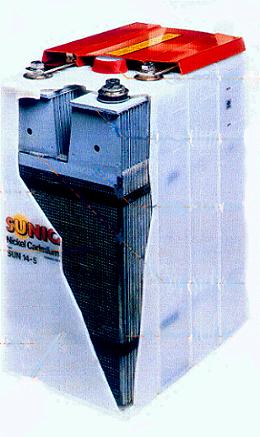Saft's record breaking battery reinforces grid in Alaska against power outages. This Battery Energy Storage System (BESS) for the Golden Valley Electric Association (GVEA) in Alaska is already capable of delivering 40MW:

On August 26, Saft, the battery company, brought the first three strings of the world's most powerful storage battery on-line to mark the official dedication of the new $30m BESS for the Golden Valley Electrical Association (OVEA) in Fairbanks, Alaska. The BESS will stabilise the local grid and reduce its vulnerability to events like the recent blackout in the northeastern US and Canada.
The Golden Valley BESS is configured to operate in several distinct modes, each of them aimed at stabilising the GVEA system if power supply problems occur. This is a critical feature for this type of system and is one reason why battery energy storage is widely regarded as a vital component of the electricity delivery infrastructure of tomorrow.
An unofficial world record:
During commissioning tests the Saft battery set an unofficial world record by achieving a peak discharge of 26.7 MW with just two strings operational. This makes the Alaskan BESS over 27% more powerful than the previous record holder - a 21 MW BESS commissioned by the Puerto Rico Power Authority (PREPA) at Sabana Llana, Puerto Rico in 1994.
Saft was awarded the contract to design and build the battery, which comprises 13,760 rechargeable cells in four parallel strings, as part of a BESS consortium led by ABB, the leading power and automation technology group, which is providing the system concept and the DC to AC power converter system. Saft is providing a 'cradle to grave' service by taking responsibility for the recycling of each nickel-cadmium cell.
Flexibility and long life:
Although the BESS is initially configured with four battery strings, it can readily be expanded to six strings to provide a full 40 MW for 15 minutes. The facility can ultimately accommodate up to eight battery strings, giving considerable flexibility to boost output or prolong the useful life of the system beyond the planned operation for 20 years.
Jim McDowall of Saft America, who is co-ordinating the BESS project, said: "During acceptance testing, the BESS was operated with just the first two of its four battery strings installed. Even so, we broke the world record by achieving 26.7 MW, and sustaining it for nearly three minutes. The third string has been brought on line ahead of schedule and in time for the start of commercial operation. When all four battery strings are in place, which is scheduled towards the end of this year, the power will increase to 46 MW, more than twice as powerful as the Puerto Rican battery. And that is when we shall be making a formal application to Guinness World Records to have the Alaskan BESS recognised officially as 'the most powerful storage battery in the world"'.
Environmental considerations:
Anthony Green, business development manager for the Saft Industrial battery Group said: "Environmental considerations are of vital importance for any project carried out in Alaska. We won this contract by convincing GVEA that nickel-cadmium batteries would represent the most environmentally friendly solution over the whole life of the BESS project. In particular, Saft's high performance nickel-cadmium batteries will last at least 20 years, compared to VRLA (valve regulated lead acid) batteries, which would probably need replacing twice during this period. So our batteries will not only prove more cost-effective over the whole life of the project, they will also consume fewer natural resources."
About the Alaskan BESS:
The Alaskan BESS will eventually comprise a total of 13,760 Saft SBH 920 high performance rechargeable nickel-cadmium cells arranged in four parallel strings to provide a nominal voltage of 5,000 V and a storage capacity of 3,680 Ah. The complete battery will weigh around 1300 tonnes and occupy a space of 9402m. In addition to supplying the nickel-cadmium cells, Saft is also providing a distributed filling system, to ensure that the cells can be easily filled with the correct level of electrolyte, together with a sophisticated electronic battery monitoring system.
Background on GVEA:
GVEA is a rural electrical co-operative, based in Fairbanks, Alaska, serving 90,000 residents spread over 2,200 square miles. Back-up power is essential to the local population, due to the extremely low temperatures, which in winter can fall to –51oC. A dwelling without power under these conditions will begin to experience frozen pipes in just a few hours.
Traditional solutions for producing reserve power require building and maintaining transmission and generation capacity well in excess of normal demand, so the BESS represents an extremely cost-effective and efficient alternative for GVEA. In operation it will produce up to 27 MW of power for 15 minutes, which allows the utility enough time to bring back-up generation on line. While the BESS is capable of producing 46 MW for three minutes, GVEA's primary need for the system is to cover the 15-minute period resulting from sudden loss of generation and start-up of back-up generation.
Contact: Anthony Green
Saft Industrial Battery Group
Tel: +33 1 49 93 17 59
Email: [email protected]
Web: www.saftbatteries.com